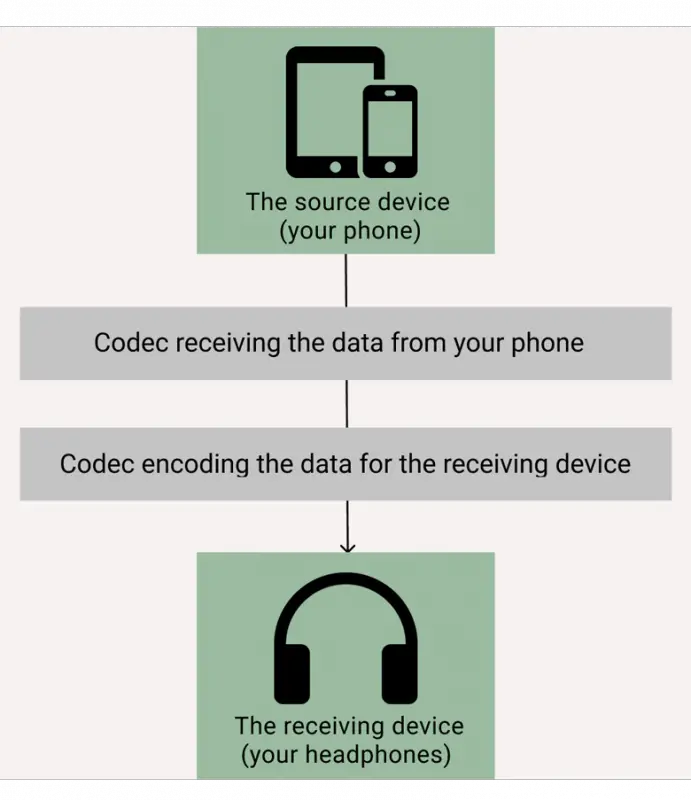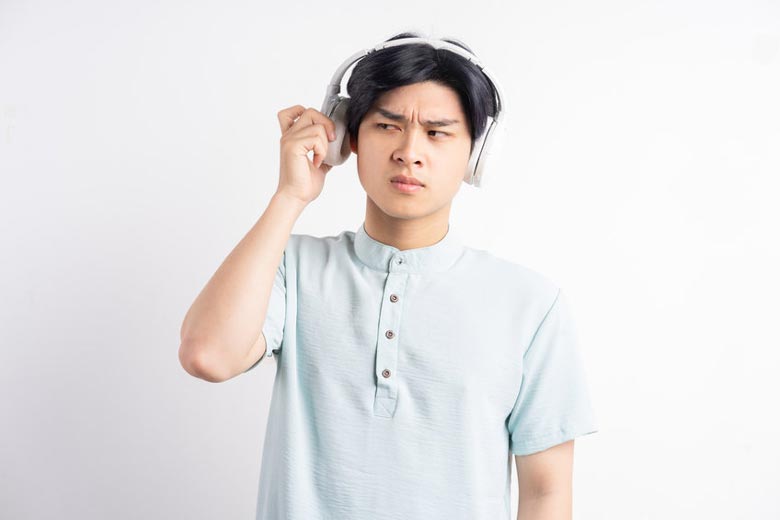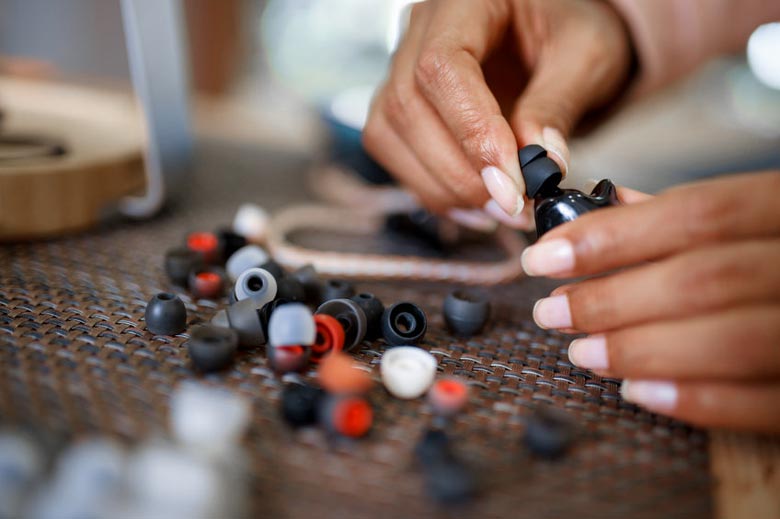If you don’t like using cables, you’ll be forced to deal with annoying Bluetooth audio quality problems. From extreme latency issues to low audio quality, it’s hard to pinpoint the reason for the low quality.
Here are 6 reasons why your Bluetooth sound quality is bad:
- The codec from your audio source is incompatible.
- Bluetooth compresses and distorts audio data.
- You’re using the Bluetooth device for input and output.
- The Bluetooth headset doesn’t fit.
- Your Bluetooth device’s battery is low.
- You haven’t adjusted your equalizer settings.
Read on to understand why the factors mentioned above affect sound quality and how to fix them. Hopefully, your Bluetooth speaker or headphones will sound at least slightly better.

1. The Codec From Your Audio Source Is Incompatible
Different Bluetooth versions have support for different audio codecs. Some codecs are better than others. However, a Bluetooth device with a high-quality codec isn’t enough. Your device also needs to be compatible with that codec, which is where the problem lies.
But first, what exactly is a codec, and how does it work?
I’d like you to look at Bluetooth as if it were a bridge:
The data source (e.g., your phone or amp) is on one side of this bridge. On the other side of the bridge is the device that receives the information. Both devices have to speak the same language to go from the music source to the headphones. Audio engineers call this language a format.
The codec receives the data from your source device and sends it to the receiving device. To help you visualize this process, I’ve created a simple diagram:

Now, the thing about the codec is that there are different versions and standards. The most popular ones are:
- LDAC
- Aptx HD
- Apt X
- AAC
- SBC
Each of these codecs functions slightly differently, impacting sound quality and latency. The consensus, though, is that apt X produces the best quality.
Here lies the problem — the codec on your Bluetooth device isn’t always compatible with the one on your phone.
In this case, both devices automatically revert to the default codec, which is SBC. SBC isn’t very good at handling high-quality audio, leading to the stereotypical sound quality you get with most Bluetooth devices.
This problem can only be avoided before purchasing the Bluetooth device. Before buying a new Bluetooth headset, you should check the device’s specifications. Also, check the specifications of your audio source (phone, amp, PC, etc.). Make sure that they align.
I’ve compiled some resources that could help:
- Check your Android codec here.
- Check your Windows PC codec here.
- Like with everything else, Apple uses a custom codec (AAC).
2. Bluetooth Compresses and Distorts Audio Data
Another reason for low sound quality in Bluetooth devices is the multi-layered compression that the sound data undergoes. The inability of Bluetooth codecs to transmit data at a high bit rate worsens the problem further.
Consider this: music is created in its purest form in the studio. The original sound quality is arguably the best it can get. But before the producer can upload it for public consumption, that song must be compressed; otherwise, it’d take too much space. That’s what causes lossy audio compression.
Lossy audio compression is a complicated problem. The simple explanation is that certain parts of the audio file are discarded during compression to make it smaller. This process happens with the assumption that the consumer won’t notice the pitched sounds.
This is true for the most part. Hence, the music you stream is often a watered-down version of the original thing, and you may not even notice it if you’re not an audiophile or sound engineer.
But where does Bluetooth come into play here?

We’ve already established one layer of compression. Bluetooth further impacts the audio quality through additional compression. We spoke about codecs in the first point, and that applies here.
You see, Bluetooth isn’t very good at quickly transmitting lots of data in real-time. Therefore, the codec has to compress the data to be shared lag-free. This means that listening to music with Bluetooth creates an extra compression layer.
Here’s an analogy:
Imagine wearing multiple layers — it slows you down. First, you take off the ring, hat, and scarf. When you’re about to enter a building, you take the coat off as well. Your outfit won’t be the same because you’ve taken multiple layers off. You still look good, but you don’t look the way you did when you first left your house.
That’s the difference between lossless and lossy audio files.
The good news is that advances in technology have started making lossless Bluetooth devices possible. Lossless means that none of the sounds are discarded during transmission.
3. You’re Using the Bluetooth Device for Input and Output
Bluetooth isn’t good at multitasking. Output audio quality suffers when using a Bluetooth device as both an input and output source.
You might’ve already noticed that output sound quality goes down when having a voice call. Since Bluetooth is used for various things, each use has its transmission profile. Each transmission profile also has a different sample rate, i.e., it transmits data at a higher or lower rate than other profiles.
Let’s explain this using a simple example:
Imagine you’re streaming a song. The Bluetooth device automatically switches to the profile for that activity. Streaming uses Advanced Audio Distribution Profile. This profile function transmits somewhere between 44,100–48,000 samples per second.
As you’re listening, you suddenly receive a call, and you want to use the same Bluetooth device for the call. The device switches to the hands-free profile that streams 8,000–16,000 samples per second. When the call is over, the device reverts to Advanced Audio Distribution.
The implication is that you’re using two different profiles whenever you’re using Bluetooth to both receive and send audio.
The consequence of this is a sudden drop in audio quality. Bluetooth headsets don’t have the bandwidth to handle both. If you’re a streamer or music producer who wants to record and listen from the same device, use a different recording device.
4. The Bluetooth Headphones Doesn’t Fit
Another factor that affects sound quality of Bluetooth devices is how the headphones fit. The main reason you use Bluetooth is the freedom it affords. You could be charging your phone in the living room while enjoying your favorite album in the kitchen.
While this freedom makes Bluetooth headphones a good tradeoff, it affects sound quality. Most headphones are a one-size-fits-all solution. What happens when the size doesn’t fit you, then?
Thankfully, many manufacturers have thought this through. You’ll notice a variety of ear tips in the packaging of your earbuds. The purpose is to help you find a perfect fit for your ears.

Take advantage of that; otherwise, you won’t enjoy the audio very much. Not only does this impact the tonality and sound isolation, but it may also even affect the noise-canceling features.
When it comes to on-ear and over-ear headphones, the only realistic solution is to try them on before purchasing. Don’t order headphones online if you think they’re not going to fit.
5. Your Bluetooth Device’s Battery Is Low
A sneaky factor is the impact of battery life on audio quality. While most of us keep our phones fully charged, we often forget to charge our wireless headphones or bluetooth devices.
See, the thing about audio Bluetooth devices is that they maintain a connection to the host device. This connection drains the battery, even when you’re not using the device. The sound quality drops whenever the device battery drops to about 20%.
One way to mitigate this is to invest in Bluetooth 4.0 or newer wireless audio devices. They do a lot more and run on less power. Many options are on the market, but this pair of Edifier Bluetooth Headphones (available on Amazon.com) has a whopping 80-hour battery life!
6. You Haven’t Adjusted Your Equalizer Settings
Have you ever fiddled with the music equalizer in hopes of getting superior sound? You’d be right to do so because this can also impact sound quality. The simple description of a music equalizer is that it’s used to adjust the frequency and tone of your audio to produce the best results.
You can adjust the equalizer of your music either from the phone settings or the streaming platform. You’ll find preset equalizer profiles ranging from blues to jazz most of the time. The purpose of these is to adjust the frequency to work in perfection to a particular genre.
The manual method is to push all the sliders to the highest level. Then, you start tweaking the sliders individually, giving you an idea of how each slider affects the sound. If you keep trying, you’ll eventually find the “perfect sound.”
